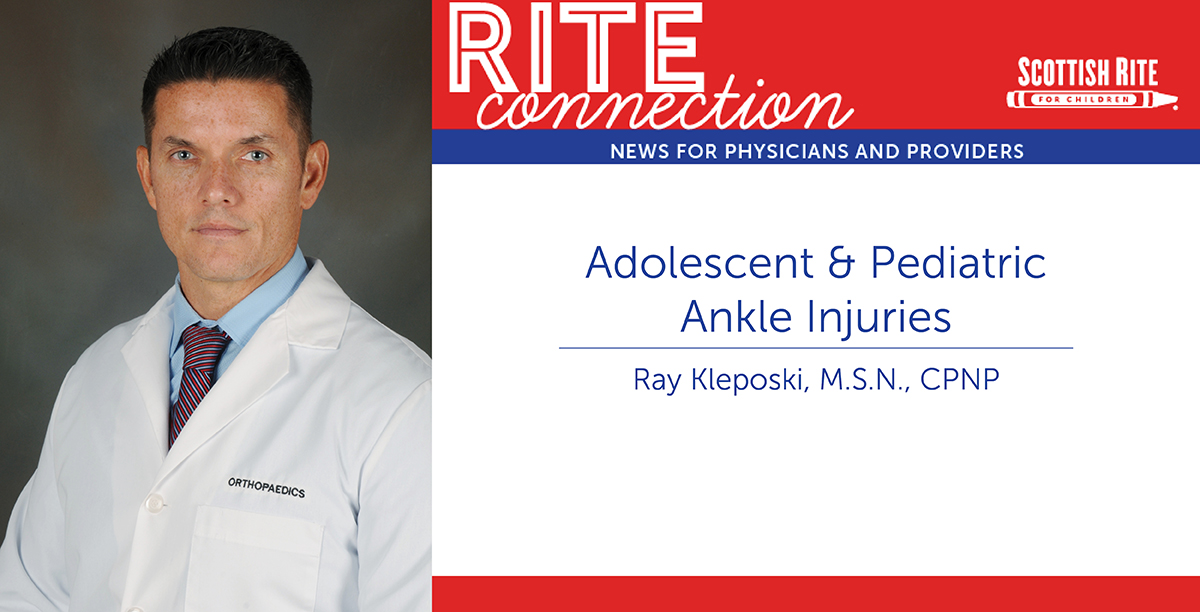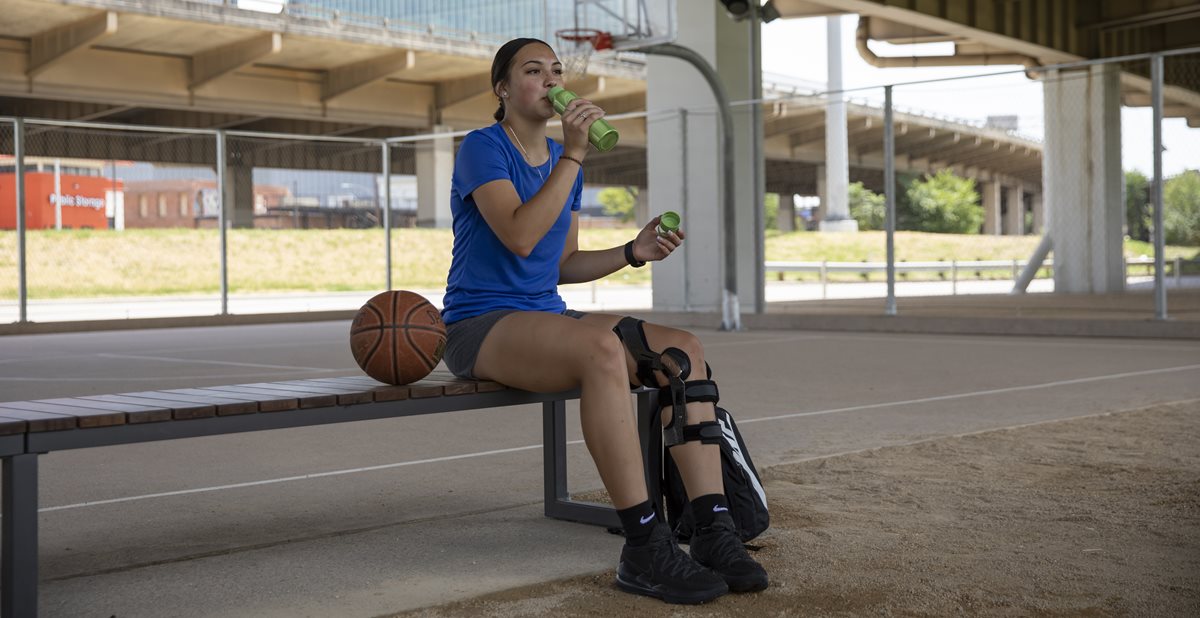
Feb 19, 2020 / Sports Medicine
Coffee, Kids & Sports Medicine - Adolescent and Pediatric Ankle Injuries
Summary of presentation at a recent Coffee, Kids and Sports Medicine educational series event in Frisco by Ray Kleposki, M.S.N., CPNP.
Read more or watch the video for the answers to these common questions:
A younger child is more likely to injure a growth plate than the soft tissue structures (ligaments), therefore it’s important to understand and consider the developing musculoskeletal anatomy. Below is a building construction analogy to help with educating families:
Ankle Sprain vs. Growth Plate Fractures
“It’s just a sprain.” Ray hears this frequently, but he warns providers to remove “just” from the conversation. When he uses the word “tear” and the analogy of a torn sweater, families begin to understand the significance of the injury.
Fractures in the growing child are categorized using Salter Harris I – V. This system references how much and how the growth plate is involved in the injury. The lower number is the least severe but still requires treatment. For Salter Harris I and II, the treatment decisions are made with similar principles in mind.
Treatment – Boot, Brace or Cast?
A recent study shows that pediatric orthopedic providers across the country use a wide variety of approaches to immobilize the ankle with a lateral injury (sprain or fracture). Most use boots. An important finding was the agreement that these injuries did need to be treated. In another survey, boots have shown to have lower complication rates than casts for this population. Ray leans toward using a boot for SHI, SHII and Grade 2 sprains. Casting may be useful in very early stages of healing for Grade 3 sprains. He advises to consider the unique situation of each child before making a decision:
Patients who present with recurrent injuries or after sustaining a significant injury may need formal therapy. Home exercise programs are typically successful for patients with minor injuries. Learn more about ankle exercise programs for recovery and prevention.
Ankle Fractures
The most common mechanism of SH III and IV ankle fracture is supination combined with external rotation (SER), which is often referred to as a “Weber B” fracture. This and other ankle fractures, including tillaux and triplanar, may require operative treatment but in some cases casting will also produce excellent outcomes.
Foot Fractures
Though the foot was out of scope for the presentation, Ray warns providers to be familiar with several common foot fractures so that they are not missed during an ankle exam.
Watch the full ankle exam video now.
Ray sees patients in the Scottish Rite for Children Fracture Clinic in Frisco. Learn more about that service including our walk-in hours.
References:
iBeck J., West N, Sabatino M, Ellis HB. 2020. Significant Variability Exists in treatment of Pediatric Lateral Ankle Injuries. Poster presentation at the 7th Annual Pediatric Research in Sports Medicine Society (PRiSM) Annual Meeting. Glendale, AZ.
iiBeck J., West N, Sabatino M, [POSNA QSVI Sports Committee, Jo C, Ellis HB. 2020. Treatment Complications of Ankle Sprains and Salter-Harris I Distal Fibula Fractures: A POSNA Survey. Poster presentation at the 7th Annual Pediatric Research in Sports Medicine Society (PRiSM) Annual Meeting. Glendale, AZ.
Read more or watch the video for the answers to these common questions:
- When do we send them to a specialists?
- When do we get X-rays?
- What do we do and how do we do it?
A younger child is more likely to injure a growth plate than the soft tissue structures (ligaments), therefore it’s important to understand and consider the developing musculoskeletal anatomy. Below is a building construction analogy to help with educating families:
- The bones are the bricks
- The growth plate is like wet mortar
- The ligaments are like cables
- Be consistent with your exam, no matter the age. Gain trust – never start by touching the injured area, especially with a young patient. Try to examine the other side first to get a feel for what the child’s “normal” ankle feels like. Start proximal to distal.
- Observe the patient walking only if they are able and willing. Look for atrophy and shape and alignment of the extremity.
- Palpate the ankle and foot structures and common locations of injuries in this population. It’s important not to ignore the foot during the ankle exam. Watch the video to observe Ray palpate anatomical structures on an eight-year-old model.
- What? AP, lateral (avoid rotation) and mortise views of ankle
- Consider adding three views of the foot with complaint of pain at fifth metatarsal or navicular.
- How? Position ankle in 90 degrees and weightbearing, if possible.
- When? Ottawa Ankle Rule (OAR) suggests to image if there is pain:
- In the malleolar zone (medial or lateral).
- Bone tenderness at distal six centimeters of the tibia or fibula.
- Tenderness to palpation at navicular or base of fifth metatarsal.
- Inability to bear weight immediately after injury or four hours later.
Ankle Sprain vs. Growth Plate Fractures
“It’s just a sprain.” Ray hears this frequently, but he warns providers to remove “just” from the conversation. When he uses the word “tear” and the analogy of a torn sweater, families begin to understand the significance of the injury.
Fractures in the growing child are categorized using Salter Harris I – V. This system references how much and how the growth plate is involved in the injury. The lower number is the least severe but still requires treatment. For Salter Harris I and II, the treatment decisions are made with similar principles in mind.
Treatment – Boot, Brace or Cast?
A recent study shows that pediatric orthopedic providers across the country use a wide variety of approaches to immobilize the ankle with a lateral injury (sprain or fracture). Most use boots. An important finding was the agreement that these injuries did need to be treated. In another survey, boots have shown to have lower complication rates than casts for this population. Ray leans toward using a boot for SHI, SHII and Grade 2 sprains. Casting may be useful in very early stages of healing for Grade 3 sprains. He advises to consider the unique situation of each child before making a decision:
- Age
- Sport
- Time of Injury
- Fracture or sprain pattern
Patients who present with recurrent injuries or after sustaining a significant injury may need formal therapy. Home exercise programs are typically successful for patients with minor injuries. Learn more about ankle exercise programs for recovery and prevention.
Ankle Fractures
The most common mechanism of SH III and IV ankle fracture is supination combined with external rotation (SER), which is often referred to as a “Weber B” fracture. This and other ankle fractures, including tillaux and triplanar, may require operative treatment but in some cases casting will also produce excellent outcomes.
Foot Fractures
Though the foot was out of scope for the presentation, Ray warns providers to be familiar with several common foot fractures so that they are not missed during an ankle exam.
Watch the full ankle exam video now.
Ray sees patients in the Scottish Rite for Children Fracture Clinic in Frisco. Learn more about that service including our walk-in hours.
References:
iBeck J., West N, Sabatino M, Ellis HB. 2020. Significant Variability Exists in treatment of Pediatric Lateral Ankle Injuries. Poster presentation at the 7th Annual Pediatric Research in Sports Medicine Society (PRiSM) Annual Meeting. Glendale, AZ.
iiBeck J., West N, Sabatino M, [POSNA QSVI Sports Committee, Jo C, Ellis HB. 2020. Treatment Complications of Ankle Sprains and Salter-Harris I Distal Fibula Fractures: A POSNA Survey. Poster presentation at the 7th Annual Pediatric Research in Sports Medicine Society (PRiSM) Annual Meeting. Glendale, AZ.



